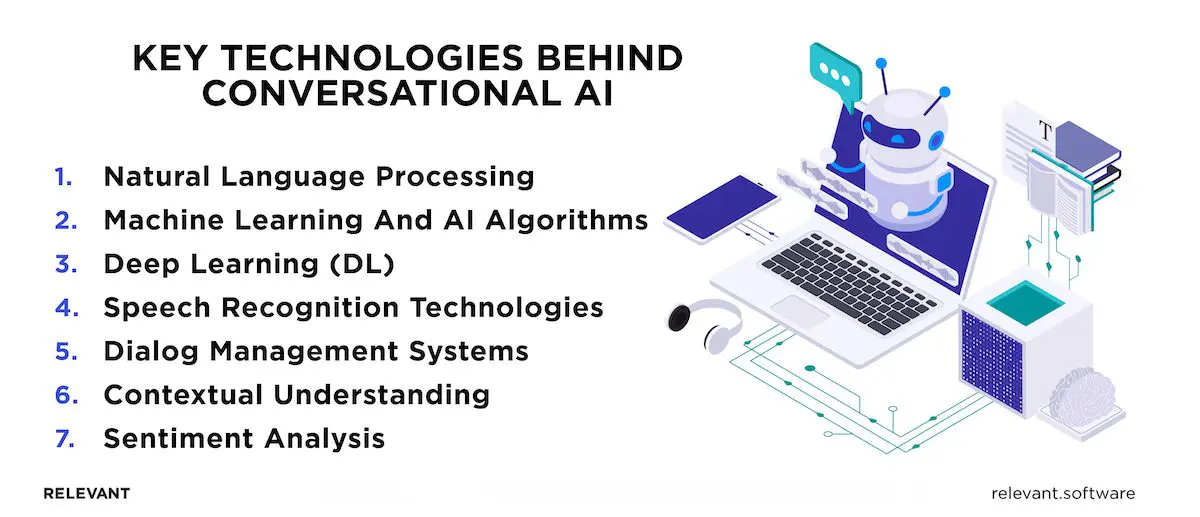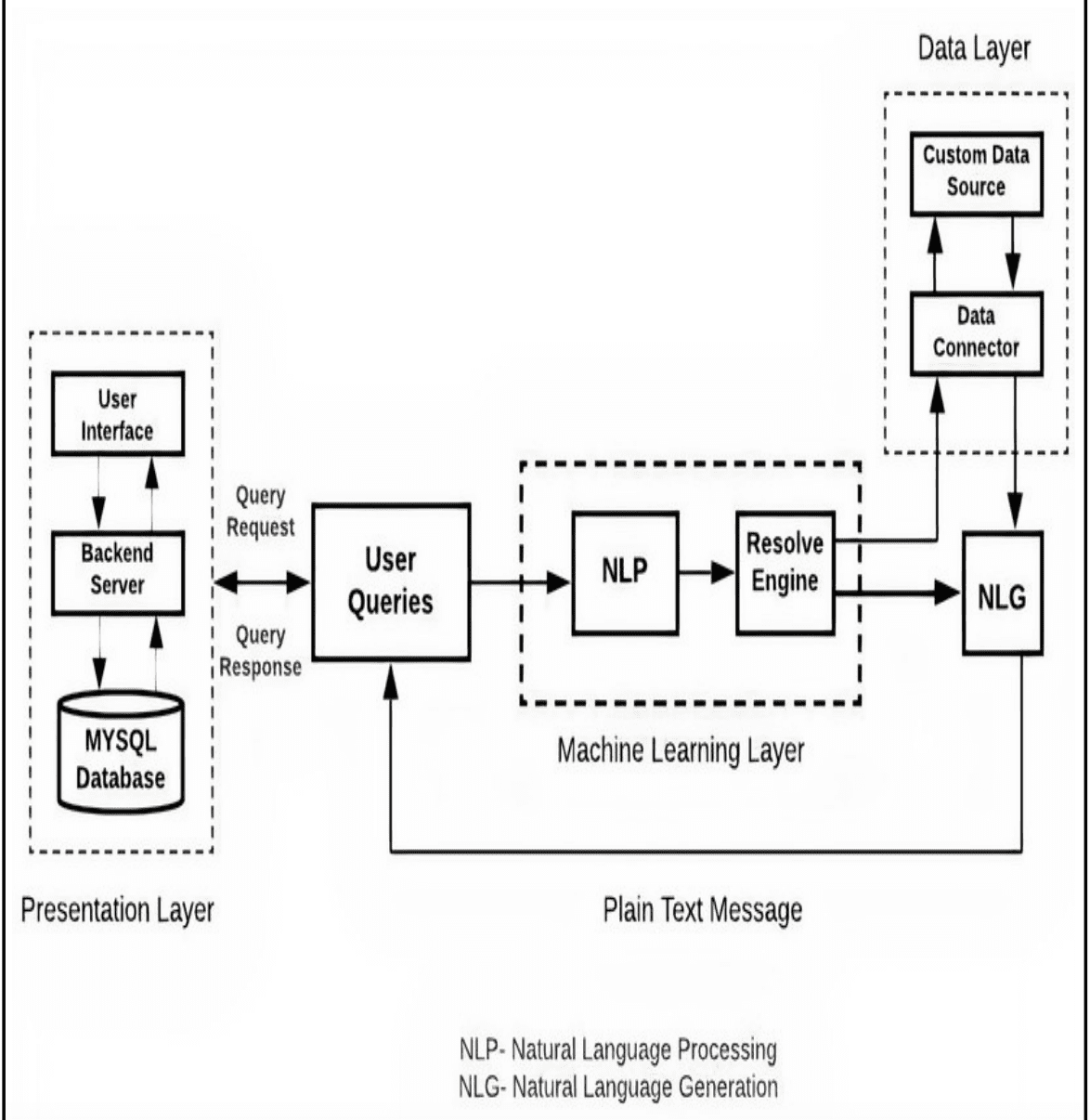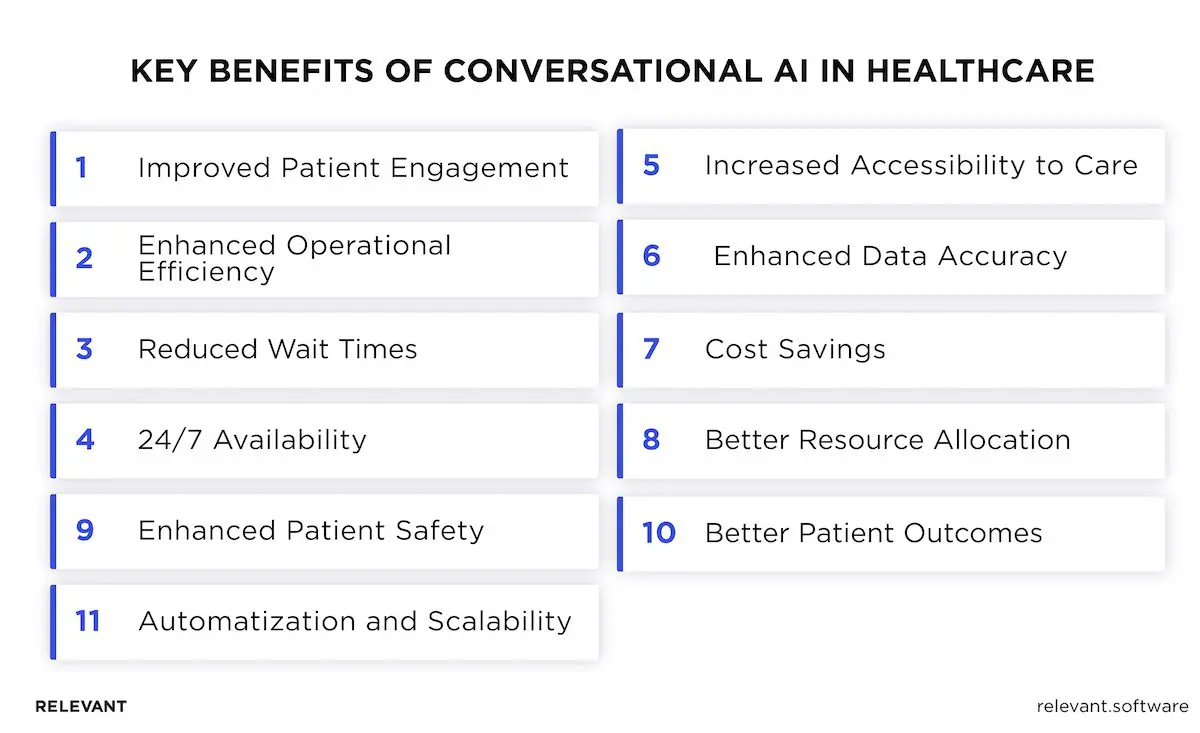Conversational AI in Healthcare: More Than Just Chatbots – Here’s Why

In 2023, a McKinsey&Company study revealed a fascinating trend: around 60% of physicians are now incorporating some form of AI into their practices, with chatbots leading the way. But doctors aren’t the only ones who value conversational AI in healthcare — patients are on board, too.
According to the 2022 PWC Health Reimagined report, 72% of patients expressed interest in AI for remote monitoring and diagnostics. This growing acceptance was further highlighted by a 2023 HIMSS Analytics survey, in which 83% of patients reported feeling comfortable sharing their medical data electronically to improve their care.
Inspired by the rising enthusiasm, healthcare organizations have begun partnering with AI companies to develop conversational chatbots, AI communication platforms, and virtual assistants. These innovative tools have already demonstrated their effectiveness. For instance, Cleveland Clinic’s AI scheduling system has reduced patient wait times by an impressive 40%, while Buoy Health’s symptom checker chatbot has successfully diverted 60% of unnecessary ER visits.
Not among the early adopters? Hurry up and read about the current benefits of conversational AI to see what you’ve been missing.
Is Conversational AI Actually What We Think It Is?
AI’s potential in healthcare includes early disease detection, diagnosis, management, and treatment. It improves patient engagement, medication adherence, elderly care, health promotion, counseling, administrative processes, and healthcare professional education. Since 2012, the rapid advancement in healthcare AI research has resulted in a growing number of FDA-approved AI-based medical solutions, a trend expected to persist.
AI types are categorized as “strong AI,” which tries to mimic human reasoning and behavior; “weak AI,” which produces human-like results using different methods; and “in-between AI,” inspired by human reasoning. Significant healthcare AI advancements today often fall in this middle category.
But, what is Conversational AI in healthcare exactly? Although terms like chatbot, virtual assistant, and conversational AI are often used interchangeably, they have distinct functionalities and capabilities. Let’s clear up some of the terminology confusion.
Chatbots
Chatbots are essentially software programs that automate interactions. However, they do not necessarily utilize natural language processing (NLP), dialog management, or machine learning (ML); many rely on scripted, pre-defined responses and rule-based programming to provide straightforward answers to specific queries.
Find out more about the impact of chatbots on healthcare here.
Virtual Health Assistants (VHAs)
These systems are more advanced and designed to serve specific purposes with specialized dialog management. They perfectly keep context across interactions, like a series of questions about symptoms, and advise on the next steps. VHAs help with chronic conditions, remind patients to take meds, support recovery, and offer health education. Accenture says VHAs could save the U.S. healthcare system $150 billion annually.
Conversational AI Solutions
Combining NLP and ML, conversational AI chatbots in healthcare offer a more nuanced and responsive approach. They decode human speech and imitate our conversational style, even in unexpected contexts.
Unlike basic chatbots, they don’t need specific keywords for comprehensive answers or consultations. NLP enables these systems to fully understand text, moving past simple keyword matching to deliver accurate and relevant responses. Moreover, due to deep analysis these AI models understand intent, helping patients even with contextual or grammatical mistakes.
Need conversational chatbot development services? Let’s connect!
Key Technologies Behind Conversational AI
Conversational AI owes its capabilities to the advanced technologies that power it.
Understanding these nuances helps you better appreciate how AI-enabled systems can hold conversations that look natural and human-like.

Natural Language Processing
NLP allows systems to interpret and understand human language, enabling them to engage in natural and intuitive conversations. NLP analyzes sentences’ syntax and semantics to grasp the context and intent behind user queries.
Machine Learning and AI Algorithms
They drive the continuous improvement of conversational AI systems. These algorithms learn from each interaction, thereby adapting and refining responses to become more accurate and contextually appropriate over time.
Deep Learning (DL)
Powered by neural networks, DL mimics the human brain’s ability to recognize patterns and learn from large datasets. For instance, embedded in AI chatbots in healthcare, DL technologies help understand and respond to intricate medical inquiries, offering precise and reliable information to both patients and professionals.
Speech Recognition Technologies
They convert spoken language into text, which allows conversational AI to understand and respond to voice commands. For instance, speech recognition technology in healthcare enables doctors to update patient records or request information without interrupting their workflow, enhancing efficiency and care quality.
Dialog Management Systems
Dialog management systems keep conversations coherent and contextually relevant. They track the flow of conversation and decide the next steps based on what users say. For instance, in healthcare applications, these systems can recall patient details from earlier in the conversation, providing more personalized and effective support.
Contextual Understanding
AI’s contextual understanding enables it to remember and use content from earlier in a conversation and offer more relevant and accurate responses. It ensures conversations flow logically and naturally, which enhances the overall user experience. For example, if a user mentions a medical condition early in the conversation, the AI can reference it later to provide more personalized advice.
Sentiment Analysis
With sentiment analysis, AI gains the ability to detect and interpret the emotional nuances in user queries. This understanding lets AI respond with empathy and appropriateness. For example, if a user is frustrated, the AI can offer more supportive and calming responses, making interactions feel genuinely personal and considerate.

How Conversational AI in Healthcare Works
Conversational AI chatbots in healthcare work through three steps:
Step 1: Initial Query Processing and Setup
Picture this: You tell an AI chatbot that you suspect you might have a cold and want a symptom list to check your condition. The process begins with Natural Language Processing (NLP), which transforms your query into a format the virtual assistant can understand. It converts your words into binary vectors that encapsulate the essence of each term. These vectors then form a matrix representing the entire sentence. The system distills this information, keeping only the crucial parts to make an educated guess at what you’re asking.
Related – What is Conversational AI
Step 2: Natural Language Understanding
After the initial configuration, DL and ML models kick in. These models, part of natural language understanding (NLU), enable the bot to recognize the topic of the user’s request. NLU spots related terms like “cough,” “sneezing,” and “rhinitis” in cold-related queries. It then evaluates different ways people might phrase the same question, as well as “What are the symptoms of a common cold?” or “I feel like I have a cold.” Such deep analysis allows the AI system to understand exactly what the user is looking for.
Step 3: Generating a Response
The virtual assistant then generates a personalized response, drawing from an extensive answer library created in the previous steps. Every interaction refines the AI’s ability to recognize different variations of intents, paving the way for more accurate responses in future conversations. Whether through text or voice, the AI adapts to provide precise answers based on the format of the query and response, depending on the conversational AI in healthcare solution in use.
Healthcare Chatbot Use Case Diagram

Source: Ijsred
Applications of Conversational AI in Healthcare
The Association of American Medical Colleges forecasts a gap of 124,000 physicians in the US by 2034, which will compound the current deficit of 17,000 primary care doctors, 12,000 dentists, and over 8,000 therapists. This results from the rise in the older population, doctors’ retirement, the increase in chronic illnesses, and pricey medical education.
Fortunately, such advanced innovations, like AI, hold great potential to alleviate this crisis. According to a McKinsey and Harvard experts report, artificial intelligence technologies like ML and NLP could save the American healthcare system up to $360 billion.
Despite these advancements, there is a valid concern that conversational AI is fully matured for direct patient care. As such, we will focus on practical, immediate applications of AI chatbots in healthcare that can make a real difference now.
Automated Patient Scheduling
Conversational AI transforms patient scheduling by allowing patients to book, reschedule, or cancel appointments through natural language interactions. Additionally, the AI embedded in patient portals can analyze booking patterns to fine-tune schedules, spot peak times, and suggest alternative slots to avoid overcrowding of emergency departments.
Patients can use the system via text or voice, which offers a seamless and user-friendly scheduling experience that integrates directly with the clinic’s electronic health record (EHR) system. Tying AI systems to EHRs helps keep all patient details up-to-date and accessible, decreases the chances of errors, and ensures that providers possess only the most recent data.
Patient Triage Analysis
In patient triage, conversational chatbots in healthcare assist by having interactive dialogues with patients to gather vital information about their symptoms and using algorithms to assess the severity. Based on this information, patients are guided to the right level of care, whether that’s an emergency room, urgent care, or a regular doctor’s appointment.
Accurate triage by AI reduces the strain on healthcare workers and ensures patients get the care they need promptly. Moreover, AI-powered triage systems continuously learn and improve from each interaction. This constant learning process helps refine the accuracy of symptom assessment and care recommendations over time.
Handling Inquiries
Handling inquiries with conversational AI takes the pressure off healthcare staff by managing routine questions and requests. Medical AI chatbots can provide quick, accurate answers, whether it’s a question about prescription refills, office hours, or insurance coverage. These systems are not just glorified FAQs; they are intelligent assistants who can understand the context and provide relevant information.
Follow-up and Post-Treatment Care
Follow-up and post-treatment care are vital for patient recovery, and healthcare conversational AI enhances this process. It can send medication reminders, monitor recovery progress, and schedule follow-up appointments. For example, after a surgical procedure, AI-driven systems can check on a patient’s progress and flag any concerns for healthcare providers, ensuring timely interventions and continuous care.
Virtual Nursing Assistants
Virtual nursing assistants (VNS), such as those developed by Sensely, provide round-the-clock patient monitoring and support. They track vital signs, remind patients about medications, and address health questions. For instance, a VNS can alert patients if their blood pressure readings are off, prompting them to act before a problem escalates. This means fewer in-person nurse visits and better-managed chronic conditions.
Diagnostics and Treatment Recommendations
Conversational AI enhances diagnostics by evaluating patient data and symptoms to give initial assessments and potential treatment options. It accesses large medical databases to offer evidence-based recommendations to doctors. AI can also identify trends and correlations in patient data, enabling earlier disease detection.
This technology supports physicians in making more informed choices, improves diagnostic accuracy and treatment success. In tandem with electronic health records (EHRs), conversational AI ensures its suggestions are personalized to each patient’s medical history and current health status.
Mental Health Support
Conversational AI healthcare can offer mental health support through chatbots that provide therapeutic interactions, monitor patients’ mental health status, and offer coping strategies. These systems are available 24/7, ensuring that support is accessible at any time. Woebot, for example, is an AI-driven mental health chatbot that provides cognitive-behavioral therapy (CBT) techniques to users. It engages in conversations to help manage symptoms of depression and anxiety, offering a supportive tool that users can access anytime. This reduces the stigma and barriers associated with seeking mental health care.
Chronic Disease Management
Managing chronic diseases requires continuous monitoring and personalized care, which conversational AI can efficiently provide. AI systems can monitor symptoms, provide medication reminders, and offer lifestyle tips to manage conditions like diabetes or hypertension. By analyzing data from various sources, including wearables, AI can spot trends and notify healthcare providers about any concerning changes. This proactive strategy helps prevent disease progression and complications. Conversational AI keeps patients engaged by providing ongoing support and guidance, which leads to better adherence to treatment plans and improved health outcomes.
Claims Processing and Management
Claims processing and management can be a nightmare of paperwork and bureaucracy, but intelligent chatbots in healthcare simplify this process significantly. They streamline claims processing and management by automating the submission and tracking of insurance claims. For instance, Olive AI integrates with healthcare providers’ systems to handle claims submissions, verify insurance details, and track the status of claims. This automation reduces administrative workload, speeds up the claims process, and minimizes errors, ensuring that providers and patients receive timely reimbursements.
Data Entry and Management
Let’s face it: data entry is tedious. Conversational AI can take over this task. It accurately inputs patient information and updates records in real-time. For example, AI can transcribe doctor-patient conversations directly into electronic health records, which ensures all details are captured without manual input. By managing data, AI frees medical staff to concentrate more on patient care rather than administrative tasks.
With these AI applications, the future of healthcare looks not only smarter but also a lot more human. But let’s be clear: AI is designed to complement, not replace, healthcare staff. It assists in making data-driven decisions, identifying patterns, and providing recommendations, but the final judgment and personalized care still come from trained medical professionals.
Your next read: Generative vs. Conversational AI
The Key Benefits of Conversational AI in Healthcare
The advantages are numerous, too many to list comprehensively. However, we must highlight the most significant and important ones.

1. Improved Patient Engagement
Conversational AI keeps patients more engaged by providing quick and personalized responses. Patients can easily ask questions, book appointments, and get reminders without the hassle of waiting on hold. This easy access makes patients feel more involved in their own care, leading to better adherence to treatment plans and overall satisfaction. When patients feel heard and valued through AI-driven conversations, they form a stronger bond with their healthcare providers.
2. Enhanced Operational Efficiency
Conversational AI handles many routine tasks, freeing up healthcare staff for more critical duties. When AI manages scheduling, answers common questions, and handles patient data, it lightens the administrative load. This leads to faster service, fewer errors, and lower operational costs. By taking on these responsibilities, AI allows healthcare professionals to focus more on patient care, improving the overall quality of service.
3. Reduced Wait Times
AI manages routine tasks and initial patient inquiries, significantly cutting down wait times. This leads to a smoother flow in clinics and hospitals, where patients spend less time waiting for basic information or appointments. Shorter wait times make the patient experience less stressful and more productive. This efficiency also allows healthcare providers to see more patients, improving overall access to care.
4. 24/7 Availability
Conversational AI provides support 24/7, which makes it easy for patients to get the information they need anytime. This constant availability is especially helpful for urgent matters that can’t wait until morning. Patients value convenience and trust quick responses. Always having help available improves satisfaction and keeps small issues from becoming serious.
5. Increased Accessibility to Care
Conversational AI tools expand access to healthcare services, especially for patients in remote or underserved areas. This technology helps patients access healthcare providers regardless of location, making medical assistance universally available. With AI, providers can extend their reach and offer crucial services to individuals who might otherwise miss out on quality care.
6. Enhanced Data Accuracy
Conversational AI chatbot for healthcare improves data accuracy by reducing human error in data entry and documentation. Nuance Communications’ Dragon Medical One is a prime example, using AI to transcribe doctor-patient conversations directly into electronic health records (EHRs). This ensures patient information is accurate and easy to access in the future. With automated data entry, Conversational AI keeps patient records precise and consistent, which is essential for proper medical care.
7. Cost Savings
Healthcare providers save costs when AI handles routine and repetitive tasks, freeing up their time to focus on patient care. For example, Providence St. Joseph Health implemented a medical AI chatbot to manage patient inquiries and appointment scheduling, which led to lower administrative costs. Automating these tasks with Conversational AI decreases the need for extra staff and reduces operational costs. The saved funds can be further reinvested in patient care and the latest medical technologies.
8. Better Resource Allocation
Conversational AI tools help healthcare providers allocate resources more efficiently. At Cleveland Clinic, AI-driven chatbots triage patients and schedule appointments based on urgency. This helps optimize the use of healthcare resources, reduce waste, and ensure that medical staff can focus on critical cases. By streamlining these processes, Conversational AI contributes to more effective and efficient healthcare delivery.
9. Enhanced Patient Safety
Conversational AI enhances patient safety by providing accurate and timely medical advice. At Mayo Clinic, for example, a medical AI chatbot offers reliable medical guidance, reducing the risk of miscommunication and errors. Additionally, AI-driven systems monitor patient symptoms and provide alerts for potential health risks, which enables early intervention. This proactive approach helps prevent complications and enhances overall patient safety.
10. Better Patient Outcomes
With AI handling routine inquiries and data management, healthcare professionals have more time to focus on direct patient care. This means much more accurate diagnoses and tailored treatments. In turn, enhanced engagement and precise data lead to better adherence to treatment plans, improving recovery rates and health outcomes. As a result, patients get more attention and personalized care, which enhances their satisfaction.
11. Automatization and Scalability
Conversational AI scales effortlessly to meet rising patient demands without sacrificing care quality. The scalability of AI-driven solutions is exemplified by Teladoc Health, which uses AI to handle a high volume of virtual consultations. During the COVID-19 pandemic, Teladoc’s AI-driven system successfully scaled up to meet the surge in telehealth appointments, which demonstrates its capacity to extend services and maintain high standards of care.
Limitations and Challenges of Conversational AI in Healthcare
Here are some key limitations in implementing conversational AI tools and possible solutions from our experts:
Diagnostic Complexity
Challenge: Many medical conditions have complex or atypical symptoms that conversational AI may not interpret correctly without human clinical insight and physical exams. Diagnoses often require radiology scans, lab tests, or procedures.
Solution: Our experts emphasize the use of AI as an assistive tool rather than a replacement for human judgment. AI can enhance but not replace the diagnostic process by integrating AI with decision-support systems that alert doctors to potential issues.
Care Coordination
Challenge: Managing medications, referrals, patient questions, and collaborating with specialists requires sophisticated reasoning and communication skills that AI has not yet achieved.
Solution: Our team designs AI tools to assist healthcare professionals by automating routine tasks and facilitating communication between various stakeholders. These tools make care coordination much smoother. They organize information and ensure that all involved parties have access to up-to-date patient data.
Building Patient Trust
Challenge: Patients may hesitate to fully rely on critical care decisions from a bot compared to a human doctor with whom they can build rapport and empathy.
Solution: To build trust, we at Relevant make sure that future AI systems will be transparent, clearly letting patients know when they’re interacting with AI and when a human will take over.
Regulatory Hurdles
Challenge: Medical bodies could scrutinize and skepticize the approval of autonomous AI doctors, with liability for any errors being a major issue.
Solution: We partner with regulatory agencies to make sure our AI tools are fully compliant with medical regulations and standards. Our focus is to enhance human roles with tools that boost compliance and mitigate liability risks.
Ethical Dilemmas
Challenge: AI is not equipped with the human ethical reasoning required for tough patient care decisions, such as end-of-life choices. It doesn’t possess the human empathy and ethical perspective necessary to make these sensitive choices, and its decisions might not always align with what is best for the patient’s well-being.
Solution: Relevant’s AI systems are designed to support ethical decision-making by providing comprehensive data and options for healthcare providers. These systems do not make final decisions but offer valuable insights to inform human judgment.
Technical Limitations
Challenge: Conversational AI systems can still misinterpret queries, provide incorrect information, or fail to understand context, especially in complex medical scenarios.
Solution: The AI systems we develop stay sharp and contextually aware with continuous learning algorithms and regular updates. We also encourage feedback from healthcare professionals to help improve these systems for better performance.
Privacy and Security
Challenge: Conversational AI tools are vulnerable to hacking, which could expose patients’ private data. This includes both the patients’ responses and the questions they ask. For example, if a patient asks a medical AI chatbot about details in their health records, it could leave those records susceptible to a data breach, risking lawsuits or fines for the healthcare provider.
Solution: Relevant prioritizes robust security measures, including encryption of data at rest and in transit and multi-factor authentication, to protect patient information.
Integration Issues
Challenge: The integration of AI with existing healthcare infrastructure, particularly EHRs, presents significant technical challenges. These include data compatibility issues, varied data formats, and the challenge of AI systems communicating effectively with legacy software.
Solution: Our skilled team can create AI solutions that can be seamlessly integrated with available healthcare systems. We ensure compatibility with all common EHR platforms and offer full support during the integration to keep disruptions to a minimum.
Best Practices for Using Conversational AI in Healthcare
To maximize the benefits of your conversational AI, follow these best practices:
- Be Transparent with Patients: Let patients know when they are speaking with an AI system. This honesty builds trust, as some may have difficulty distinguishing between human and AI interactions. Being upfront ensures a positive relationship from the start.
- Facilitate Seamless Handoffs to Human Agents: Ensure that patients can easily switch to a live healthcare professional when needed. AI systems should smoothly transfer the conversation, providing relevant details such as the patient’s name and issue.
- Engage Patients on Their Preferred Channels: Meet patients where they prefer to communicate, whether through social media, messaging apps, or other platforms. Ensure your AI is accessible on these channels.
- Align AI Personality with Your Brand’s Tone: Your AI system might be the first point of contact with your healthcare service, so it’s crucial that its personality reflects your brand’s voice and tone, providing a consistent experience. A well-aligned AI personality can make interactions feel more personal and reinforce your brand’s values.
- Partner with a Trusted AI Provider: This means your healthcare organizations can benefit from AI-driven improvements and innovations more quickly. Outsourcing to a specialized AI provider allows you to leverage their existing infrastructure, tools, and skilled workforce, reducing overall costs and speeding up the healthcare software development process.
- Stay Updated on AI Advancements: AI technology (be it conversational or other) is continuously evolving. Allocate a budget for AI investments to ensure your conversational tools stay ahead and continue to deliver top-notch performance.
Conversational AI in Healthcare: Bottomline
What is conversational AI’s ultimate aim in healthcare? It unquestionably focuses on creating a more human-centered healthcare system. In this novel intelligent paradigm, patients more actively engage in their care. They are informed, empowered, and seen as individuals with unique needs and preferences, not just cases of symptoms and diseases.
Healthcare providers, meanwhile, have evolved from mere caregivers to conversationalists. They connect with patients, treating not just diseases but the whole person. The power of technology enhances, rather than replaces, human connection.
If you’re ready to unlock conversational AI’s potential for your practice, contact Relevant Software for assistance. The future of healthcare will be AI-driven, so with our adept AI engineers, you’ll always be at the forefront of innovations!



